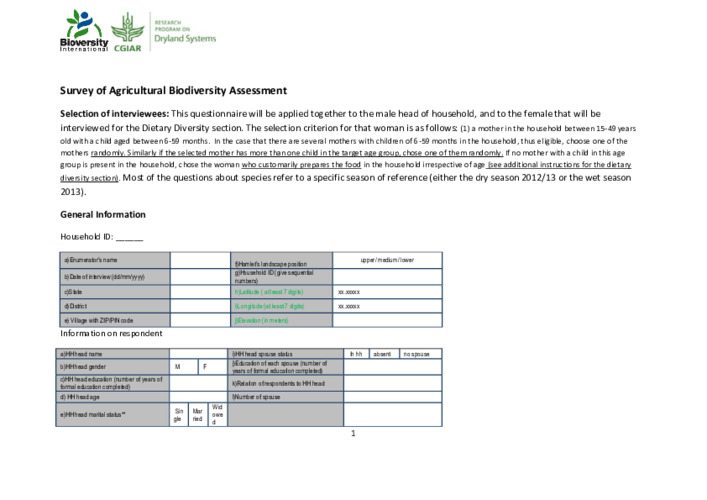Mali Household Surveys for Agricultural Biodiversity Assessment: Questionnaire (EN)
Abstract
To identify and quantify the number of all plant and animal species (domesticated and wild) and within each species, the number of types/varieties/breeds at the household-level that are: (a) grown on farm and home garden, or collected from the wild; (b) consumed as part of the diet; and (c) purchased and sold in the study sites. Information was collected for each species on its place of production or collection (farm, home garden, collected in the wild, etc.), the objective for its production or collection (Self-consumption, sale in the market, both), its different uses (food, medicine, animal feed, building material, processing, etc.), seasonality, the number of types, varieties and breeds recognized and used, key characteristics of its seed system (sources of seed, transactions and social relationships), and the water regime associated with its production (rainfed, irrigated, water harvest, etc.). Also data on assets and other socioeconomic indicators were collected. A household survey was carried out with a representative random sample of 60 households per village in three villages in the region of Sikasso in Mali (part of the Wa, Bobo and Sikasso transect where the CRP Dryland System is working in West Africa). Two of the villages (Fakoro and Kani) were also part of overall baseline survey conducted by ICRISAT. A third village, N'goutjina, was added by Bioversity. The total sample size is 180 households. The three villages in the Sikasso District of Mali: were: Fakoro (Lat 12°13074, Lon 005°20156); Kani (Lat 12°15011, Lon 005°10827); N'goutjina (Lat 12°17961, Lon 005°28372)

